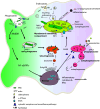Molecular basis of mycobacterial survival in macrophages
- PMID: 27866220
- PMCID: PMC11107535
- DOI: 10.1007/s00018-016-2422-8
Molecular basis of mycobacterial survival in macrophages
Erratum in
-
Author Correction: Molecular basis of mycobacterial survival in macrophages.Cell Mol Life Sci. 2018 Jan;75(1):161. doi: 10.1007/s00018-017-2683-x. Cell Mol Life Sci. 2018. PMID: 29022045 Free PMC article.
Abstract
Macrophages play an essential role in the immune system by ingesting and degrading invading pathogens, initiating an inflammatory response and instructing adaptive immune cells, and resolving inflammation to restore homeostasis. More interesting is the fact that some bacteria have evolved to use macrophages as a natural habitat and tools of spread in the host, e.g., Mycobacterium tuberculosis (Mtb) and some non-tuberculous mycobacteria (NTM). Mtb is considered one of humanity's most successful pathogens and is the causal agent of tuberculosis, while NTMs cause opportunistic infections all of which are of significant public health concern. Here, we describe mechanisms by which intracellular pathogens, with an emphasis on mycobacteria, manipulate macrophage functions to circumvent killing and live inside these cells even under considerable immunological pressure. Such macrophage functions include the selective evasion or engagement of pattern recognition receptors, production of cytokines, reactive oxygen and nitrogen species, phagosome maturation, as well as other killing mechanisms like autophagy and cell death. A clear understanding of host responses elicited by a specific pathogen and strategies employed by the microbe to evade or exploit these is of significant importance for the development of effective vaccines and targeted immunotherapy against persistent intracellular infections like tuberculosis.
Keywords: Immune evasion; Inflammatory signaling; Intracellular pathogens; Phagocytosis; Phagosome maturation; Tuberculosis.
Conflict of interest statement
The authors declare that they have no conflict of interest.
Figures


References
Publication types
MeSH terms
LinkOut - more resources
Full Text Sources
Other Literature Sources

